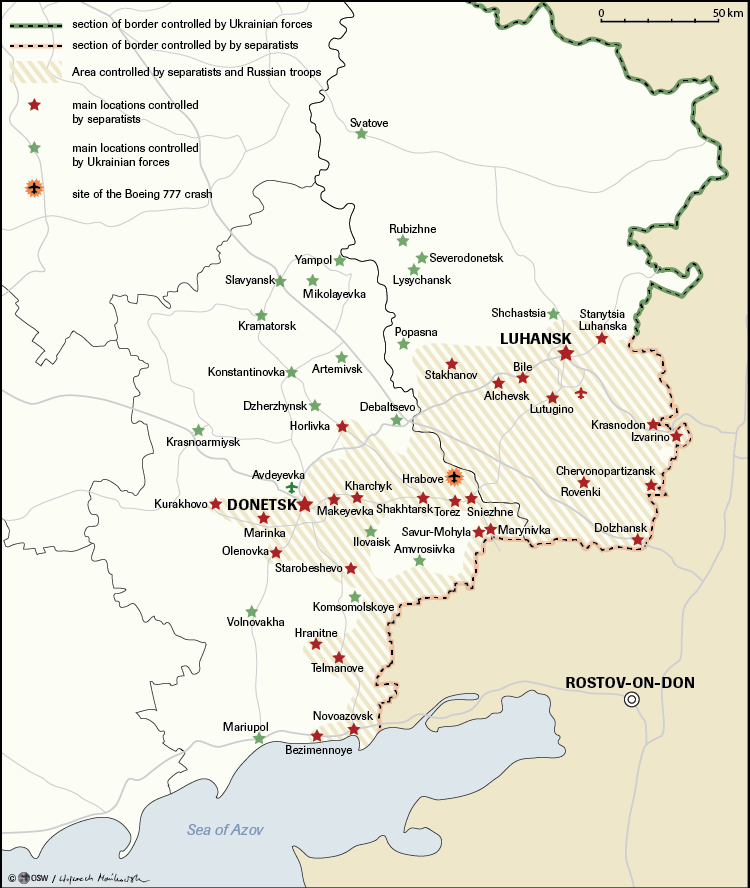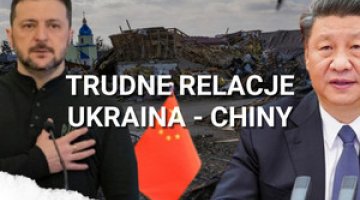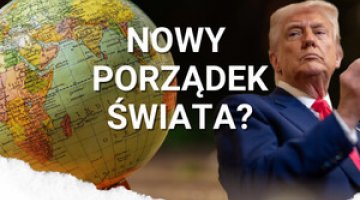The Russian military intervention in eastern Ukraine
On 24 August, regular units of the Russian army crossed the border in eastern Ukraine. The Russian offensive has led to the seizure of areas of the Donetsk and Lugansk regions hitherto been controlled by Ukrainian forces, which suffered significant loss of life. The Kremlin’s political decision to launch a direct military intervention was apparently a reaction to the threat of the effective collapse of the so-called Donetsk and Lugansk People's Republics. The main objective of the Russian offensive is to demonstrate to the government in Kyiv that it cannot resolve the conflict through military means, and that it is necessary to start talks with the separatists (and de facto with Russia) on the political and geopolitical status of Ukraine. This would lead to a political agreement which creates the mechanisms for making Ukraine dependent on Russia. The current military situation has put Ukraine and its government in a difficult political position. Above all, the authorities in Kyiv are trying to obtain political and financial support from the West. The conditions imposed by the Russians in the form of an ultimatum are unacceptable both for the government and Ukrainian society as a whole. The parliamentary elections on 26 October will be crucial for Ukraine, and in this situation Kyiv will try to delay the adoption of any unfavourable political agreements with Russia to resolve the conflict.
The increasing involvement of the Russian army
The increasing progress being made since June by the Ukrainian forces, which resulted in the pro-Russian forces gradually losing control over strategic points of the communication lines between the cities they held, and the emerging possibility of Donetsk and Lugansk being surrounded by Ukrainian forces, has been met by increasing use of regular units of the Russian army. In addition to introducing supplies of ammunition and modern military equipment from Russia, as well as personnel support for the separatist forces (including sending troops from Russia-based units who are nominally ‘on leave’), units of the Russian army have also taken part in the fighting, providing artillery fire support. Near the eastern border of Ukraine a contingent of units from the Western, Southern and Central Military District, numbering about 45,000 troops, has been assembled. There has also been a change in the separatists’ tactics; they have regrouped their forces, concentrating them around the larger towns, and preparing for the long-term defence of Donetsk and Lugansk. As a result of Russia's increasing involvement, the progress of the Ukrainian forces has lost momentum, and they are now encountering well-organised resistance. The Ukrainian units’ situation has been worsened by the stretching of their supply routes, which are constantly exposed to enemy attacks, and by progressive fatigue caused by the lack of troop rotation. Another adverse factor impeding the achievement of military success, as confirmed by representatives of the Ukrainian authorities, has been the lack of intelligence to predict the enemy’s movements.
The Russian intervention
Exploiting the deteriorating situation of the Ukrainian forces, and unafraid of a strong response from the international community, the Russian authorities decided to involve regular units of their armed forces in the fighting in the Donbas. On the morning of 24 August, regular Russian army units crossed the border of Ukraine. They took independent action, striking in the direction of Volnovakha and Lugansk and along the coast of the Azov Sea, occupying Novoazovsk on27 August. The strike by Russian troops was accompanied by the intensification of fighting by the separatist forces in other areas, gradually receiving support from troops of the Russian Airborne Forces. As a result, at least four Ukrainian groupings, in the vicinity of Ilovaysk, Amvroseyevka (on 27 August, the Ukrainian defence of the strategic Saur-Mogila hill finally fell), as well as to the south and west of Lugansk, whose total number is estimated at seven thousand soldiers, were surrounded. Despite the Ukrainian authorities’ public statements, these forces have not received the support to leave the area which they were promised. On 1 September, Ukrainian forces were driven from the airport in Lugansk, and the main burden of the fighting moved to the vicinity of Donetsk.
In the first stage, the aim of the work of the Russian-led offensive is to remove the Ukrainian forces from most areas of the Donetsk and Lugansk regions, to take control of the boundary line with Russia (including the shoreline of the Sea of Azov) and possibly to take Mariupol. This will allow the Russian side to retain the potential freedom to continue combat operations aimed at the Kharkiv and Zaporozhe regions. It is expected that the involvement of regular formations of the Armed Forces of the Russian Federation will grow.
The political motives and objectives of the Russian offensive
The Kremlin’s political decision to launch a limited, direct military intervention in Eastern Ukraine was apparently a reaction to the threat of the effective collapse of the so-called Donetsk and Lugansk People's Republics, which in the Kremlin’s perception would hinder and postpone the opportunity to implement Russia’s plans for the political subordination of Ukraine. Moreover, it would draw accusations from nationalist circles in Russia that the authorities of the Russian Federation had left the population of the Donbas to their fate, and betrayed Russia’s national interests.
This intervention is intended to serve several purposes simultaneously. Firstly, it demonstrates that there is no alternative to political negotiations with the separatists and Russia, taking into consideration its key demands. The Kremlin has shown the Ukrainians that by its decisions and actions, it can easily frustrate the military successes of the Ukrainian army; and as it has significant military reserves, it can increase its military presence in eastern Ukraine and maintain its military superiority, regardless of the number of Ukrainian forces sent to the ‘eastern front’. This means that Russia will put pressure on President Petro Poroshenko by, for example, threatening to weaken his position before the early parliamentary elections in Ukraine scheduled for 26 October, which are key to his political plans.
Secondly, Russia has demonstrated to the leaders of Western countries (especially Germany) that it is ready to lay bare their ineffectiveness in the face of Russian military aggression. Russia has also pre-emptively warned Western countries against making any attempts to assist the military in Ukraine (President Putin warned against this on 29 August, noting that Russia is a nuclear power). In this way, Russia is suggesting that the only way for the leaders of the West to save face and credibility is to exert effective pressure on Kyiv to agree to a ceasefire, i.e. a de facto freezing of the conflict, which would give room for the separatists to consolidate their forces, and for Kyiv to seek a modus vivendi with Russia.
Thirdly, by escalating the military action, Russia wants to show that the theses and proposals formulated by President Putin on the political and geopolitical status of Ukraine should be taken seriously, and should be adopted as the subject of talks with Moscow. It is no coincidence that the Russian military offensive took place simultaneously with the meeting at the summit made up of the Eurasian Union (Russia, Belarus and Kazakhstan), Ukraine and the European Union on 26 August in Minsk. In his speech there, President Putin firmly restated the basis of his concept: that Ukraine is part of the historically shaped, natural sphere of influence of Russia; and of the area of the process of economic integration (controlled by Russia); that the states which are part of the area have only limited sovereignty, which means that they cannot make any choices in domestic, foreign, economic and security policies which would conflict with the interests of the Russian Federation (as defined by Moscow).
The ‘Novorossiya’ project
The Russian military offensive in eastern Ukraine has been accompanied by more pronounced use by the Kremlin of rhetoric that refers to the so-called ‘Novorossiya’ concept, which has been used in the political language of some separatists and Russian nationalists. It is worth noting that the Russian troops who marched into the Ukrainian town of Novoazovsk on 27 August did so under a ‘flag’ of Novorossiya.
Historically, Novorossiya is the collective name of the lands of the Black Sea and Crimea, which became part of the Russian Empire in the late eighteenth century as a result of wars with Ottoman Turkey, and which only briefly acquired the status of a separate province. In the early 20th century, they became part of the emerging Soviet Ukraine, something which President Putin criticised in his address to the Federal Assembly on 18 March, calling the area “the historical south of Russia”. In turn, during a videoconference on 17 April, President Putin used the term ‘Novorossiya’, listing its parts as the Ukrainian oblasts of Kharkiv, Lugansk, Donetsk, Kherson, Mykolaiv and Odessa. Since then, the term has become widely used in the Russian state-controlled media. The campaign for “unifying” the so-called Donetsk and Lugansk republics into a ‘Novorossiya’ confederation has also been undertaken by the Ukrainian politician Oleg Tsariev, who has been supported politically and in propaganda by Russia; the creation of a confederation formally took place in May and June. Also in June, Tsariev proposed an initiative to write, by Russian historians, a textbook entitled The History of Novorossiya, which at the end of August received the official support of Sergei Naryshkin, the chairman of the State Duma, and the Russian Academy of Sciences. In addition, on the night of 28 to 29 August, the Kremlin published a call by President Putin for "a popular uprising in Novorossiya", in which Putin noted the separatists’ significant military successes and urged them to agree to create a corridor for the safe evacuation of surrounded Ukrainian forces. Finally, on 31 August, the Kremlin’s spokesman Dmitry Peskov said that President Poroshenko cannot negotiate with Russia (which is not a party to the Ukrainian conflict), only with Novorossiya.
These statements and actions clearly show that the case of the so-called ‘Novorossiya’ is a political project of the Kremlin. Novorossiya is an important part of Russia’s wider plan for Ukraine, which assumes its non-aligned status, its surrender of plans for European integration, the broad autonomy of the Ukrainian regions, and Ukraine being kept in a state of permanent economic and political crisis, which will give Moscow an instrument for influencing Kyiv. The Kremlin suggests that it is ready, should it prove necessary, to continue military aggression and subversion, which in the longer term would lead to the division of the Ukrainian state and the establishment of the so-called Novorossiya as a separate entity under Russian protection. On the other hand, if the Ukrainian government agrees to start talks with the separatists and de facto with Russia on the basis of the latter’s demands, the so-called Novorossiya area (which initially covers the Donetsk and Lugansk region, but would in the future expand to the other regions of south-eastern Ukraine, thanks to an agreement on ‘federalisation’) would formally remain part of Ukraine, while actually becoming the foundation and instrument of a Russian protectorate over Ukraine.
Kyiv in trouble
The current military situation leaves Ukraine's its government in a difficult political position. The successes for the Russian and separatist troops mean that Kyiv has lost the combat initiative in the east of the country, which it managed to gain in July after the expulsion of the separatists from an area north of the Donetsk-Lugansk line and on the border with Russia in the southern parts of both regions. Major casualties (both killed and taken prisoner) and losses hardware have weakened the military potential of the Ukrainian forces and reduced the possibility that they can recover the lost areas and complete the anti-terrorist operation with success. The difficult situation has been worsened by the economic crisis and the shortage of financial resources, which has prevented the Ukrainian units from being adequately equipped.
At the same time the mood of Ukrainian society is worsening, and criticism is growing, currently mainly directed to the military command and officials, although this could also extend to the most senior civilian authorities. The losses in battle and the funerals of soldiers (especially the defeat near Ilovaysk, where battalions of volunteers were not provided with support) have resonated strongly throughout the country.
In reaction to the invasion by Russian troops, the authorities in Kyiv have given top priority to intensifying their diplomatic efforts to strengthen their international support, especially from the EU and the United States. On the one hand, Kyiv is seeking political as well as financial and military/technical support (e.g. military equipment). On the other, it is pushing for increased pressure on Russia (e.g. through the extension of sanctions). Among other moves, the visit by President Poroshenko to Brussels on 30 August had this as its aim: he took part in a meeting of the European Council, and held bilateral meetings with the heads of states and EU institutions.
President Poroshenko has emphasised his willingness to talk and find a diplomatic settlement to the conflict (including another meeting of the Contact Group, which contains representatives from Ukraine, Russia and OSCE as well as the separatists, on 1 September in Minsk; their next meeting is scheduled for 5 September). However, the conditions imposed by Russia (i.e. the federalisation of Ukraine, autonomy for Novorossiya, withdrawing from the Association Agreement with the EU) are not acceptable to Kyiv at this stage. The president and the government are coming under great public pressure. Strong radical sentiments are rising (which is reflected in the growing support for parties employing pro-war and anti-Russian rhetoric), and any possible compromise with Russia could cause an explosion of discontent. Compromise on Russia’s terms is also not acceptable for Ukraine’s political and business elites, as this would seriously weaken their position in the country and effectively reduce them to the role of Russian supplicants (both politically and in business).
In the current situation, Kyiv finds itself on the defensive, and without the support of the West, it will not be able to cope with the difficult situation in the fighting in the east of the country, the weakening potential of its military forces, and the economic crisis. Currently the Ukrainian authorities’ political priority is holding the parliamentary elections scheduled for 26 October (as the current parliament is incapable of effective action). Therefore, Ukraine will continue to seek external support; as far as possible, to try and prevent Russia and the separatists from expanding the area under their control; and to try at all costs to conduct the parliamentary elections, while delaying any agreement with Russia which would require a far-reaching concessions (at least until the elections).
Map
Situation in eastern Ukraine (as of 3 September)

Appendix
Russian forces involved in Ukraine
The Russian grouping on the south-eastern borders of Ukraine, which include the units participating in the activities in the Donbas, consists primarily of battalion and company tactical groups sent from the tactical units of the Southern Military District, as well as units of the Airborne Forces (VDV) and Spetsnaz GRU stationed in the Western and Central Military Districts. According to information from the Ukrainian National Security and Defence Council, these groups number about 1600 people, with the number of separatist forces (including Russian volunteers fighting in their ranks and 'seconded' soldiers) is estimated at about 15,000 people. Identifying the subunits of the Russian groups involved in the intervention in Ukraine is complicated, and has been based on information about fatalities (around 60 people at least) or captured Russian soldiers. On this basis, it can be concluded that soldiers of the following units are directly involved in the fighting: the 76th Pskov Air Assault Division (10 soldiers captured by the Ukrainians arrived with this unit); the 98th Ivanovsk Airborne Division (soldiers from the 331st regiment of the division stationed in Kostroma came to the Donbas); the 106th Tula Airborne Division; and the 9th Mechanised Brigade from Nizhny Novgorod. The Donbas is also receiving weapons (mainly tanks and artillery) and soldiers from units of the Land Army, mainly mechanised brigades stationed in Chechnya. The soldiers are not wearing insignia, which resembles the situation observed in Crimea when it was overrun by the Russian army.





